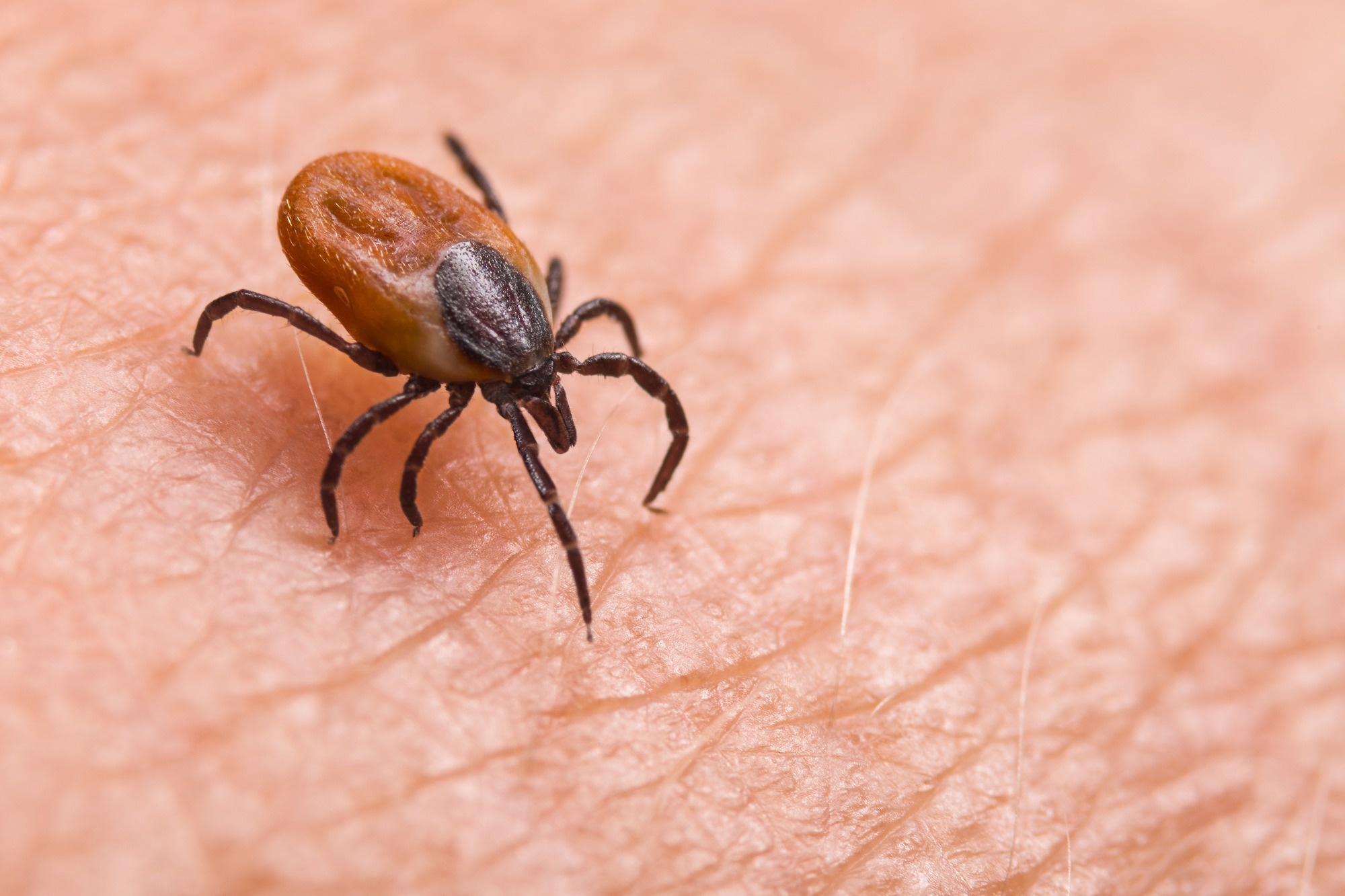In a recent study published in the Emerging Infectious Diseases Journal, researchers isolated a novel virus of the Orthonairovirus genus from samples of the Dermacentor silvarum tick species near the border between North Korea and China.
 Study: Novel Orthonairovirus Isolated from Ticks near China–North Korea Border. Image Credit: KPixMining/Shutterstock.com
Study: Novel Orthonairovirus Isolated from Ticks near China–North Korea Border. Image Credit: KPixMining/Shutterstock.com
Background
Ticks often transmit viruses belonging to the Orthonairovirus genus and Nairoviridae family. This includes the Nairobi sheep disease virus, Crimean-Congo hemorrhagic fever (CCHF) virus, and several poorly characterized viral organisms isolated from mammals and ticks.
Viral particles of Orthonairoviruses are shaped as spheres with diameters ranging between 80.0 and 120.0 nm, they contain three segments of single-stranded ribonucleic acid (RNA), and lengths range between 17.0 and 23.0 kilobases. The virions have a membranous envelope.
Continued viral surveillance could enable the identification of new viral species and facilitate early diagnosis and prompt treatment of infections caused by them, thereby reducing the global health burden of viral infections.
About the study
In the present study, researchers reported on the detection of a new Orthonairovirus, Dermacentor silvarum, near the border in the North Korea-China border region.
On 17 April 2021, the team collected ticks by dragging corduroy through a forest in Antu, proximal to the China-North Korea border. They identified ticks based on morphologic variables. The ticks were homogenized and inoculated onto Vero E6 cell supernatants. After three consecutive passages, cytopathic effects (CPE) were observed in the cells.
The team fixed cells demonstrating CPE and lodged them into epoxy-type resin blocks. Subsequently, ultrathin cellular sections were obtained and stained for transmission electron microscopy (TEM) analysis.
Viral ribonucleic acid was extracted from the infected cell supernatants, complementary deoxyribonucleic acid (cDNA) was synthesized, DNA libraries were prepared, and Sanger sequencing was performed. Subsequently, the viral reads were filtered based on their quality and length.
Contigs were prepared by assembling the genetic components de novo and aligning, according to the National Centre for Biotechnology Information (NCBI) database, and viral reads were identified by phylogenetic analysis.
Rapid amplification of complementary deoxyribonucleic acid end (RACE) polymerase chain reaction (PCR) was performed to quantify viral reads. The novel viral genomes were uploaded to the GenBank genetic sequence database.
Open reading frames (ORFs) were identified, and sequence similarity was determined.
Results
In total, 264.0 ticks of three different species, i.e., Ixodes persulcatus (n=29), Dermacentor silvarum (n=193), and Haemaphysalis concinna (n=12), and larvae of unidentified tick species (n=30), were identified. The Dermacentor silvarum tick inoculates, YB_tick_2021_24, showed cytopathic effects among Vero E6 cells four days post-inoculation.
The transmission electron microscopy analysis showed enveloped viruses, with a diameter of 100.0 nm, sharing morphologic characteristics with Bunyavirales viruses.
In total, 40,826,350.0 and 266.0 viral reads and related contigs were generated. Of which three contigs, the small contig including 1,516.0 base pairs, the medium contig including 3,936.0 base pairs, and the large contig including 12,133.0 base pairs, belonged to the Songling virus (SLV), an Orthonairovirus.
Mean sequencing coverage values obtained after remapping the three virus-associated small, medium, and large segments were 48.0, 63.0, and 234.0, respectively.
The RACE analysis demonstrated final genomic lengths for the large, medium, and small segments of 12,001.0 base pairs (coding for 3,950.0 amino acids), 4,099.0 base pairs (coding for 1,263.0 amino acids), and 1,848.0 base pairs (coding for 488.0 amino acids), respectively.
Phylogenetic analyses showed the viral strain belonged to the Orthonairovirus genus and the Nairoviridae family of viruses and was genetically similar to SLV.
The nucleotides at the terminal ends of the small segment were similar to orthonairovirus nucleotides, whereas those of the medium and large contigs differed.
Analyzing the genetic identity between the YB_tick_2021_24 strain and the YC585 sample of SLV showed 72% similarity in amino acids and nucleic acids (NA) for the small segment and 80% and 72% similarity in amino acids and NA, respectively, for the medium segment.
The corresponding similarity percentages for the large segment were 85% and 73%, respectively. The findings indicated the viral strain denoted a novel species of Orthonairoviruses. The YB_tick_2021_24 or Antu virus strain was uploaded to the National Pathogen Resource Centre data archives.
Conclusion
Overall, the study findings highlighted the isolation of a new orthonairovirus from the Dermacentor silvarum tick species, as indicated by the amino acid and nucleotide sequence similarities and phylogenetic analysis results.
The isolated virus was genetically similar to the Songling virus. Previous studies have reported that orthonairoviruses such as SLV and Tamdy viruses can infect livestock and humans.
Therefore, surveillance efforts must be increased to diagnose and treat Antu virus infections among susceptible hosts in endemic regions at the earliest.

